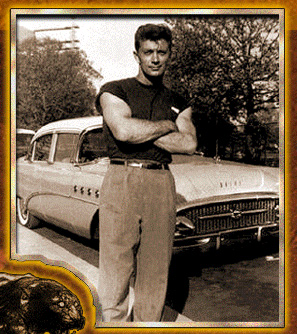
Frank Frazetta
Everything about Frank Frazetta's art is bigger than life. Born in Brooklyn, NY, in 1928, his talent was so prodigious that he had his first professional comic story, "The Snowman" in Tally-Ho Comics, published in 1944 at the tender age of 16. During the 1940's, his primary outlet was Standard (or Nedor) Publishing Co. for which he did hundreds of small illustrations that were used to illustrate text stories. Titles include Barnyard, Coo Coo, Goofy and Happy. He did a few stories for these titles, plus occasional forays into "serious" genres like crime and westerns. And even then, he was learning how to paint, as the fairy from 1949 attests.
In the early 1950's, Frazetta burst upon the mainstream comic scene with an incredible explosion of talent and energy. He did series for DC ("The Shining Knight" in Adventure Comics), ME ("White Indian" in Durango Kid), Toby ("John Wayne" in John Wayne Comics, with Al Williamson); covers for Eastern (Heroic Comics), Famous Funnies (Famous Funnies Comics - the classic "Buck Rogers" covers), ME (Bobby Benson's B-Bar-B Riders, Ghost Rider, Straight Arrow, and Tim Holt); and stories (some solo and some with Williamson and friends) for ACG, Avon, DC, Eastern, EC, Standard, and others. Plus he was doing his own newspaper strip, "Johnny Comet".
In 1953, this amazing powerhouse of energy was harnessed by a combination of laziness, money and his love of goofing off and playing baseball (Frank was scouted by the pros - I'm glad he chose art!). He went to work for Al Capp assisting him on "Li'l Abner" - a position he held for eight or nine years. His comic book work tailed off to nothing by 1955 and he seemed to simply disappear from the world of art and comics, smothered under the Capp house style.
The Capp experience took a couple of years to recover from. When he quit he thought he'd just storm back into comics, but the market had drastically changed by the early '60s. His first jobs were for men's magazines (like Gent and Dude) and for a couple of sexy paperbacks referred to as "The Midwood Doubles". For these, Frazetta did interior drawings which have since been reprinted as The Sensuous Frazetta, The Frazetta You Didn't Know About, and elsewhere.X
He never really did get back to comics, though. Roy Krenkel, one of the Fleagles from the EC days, convinced him to try his hand at painting paperback covers and helped him out on his first few jobs - "Tarzan" covers for Ace Books. In 1964 Jim Warren recruited him to do a comic story for the first issue of his new magazine, Creepy. It was to be the last pen & ink comic strip Frank was to do. At about the same time an issue of Mad Magazine appeared with a Frazetta back cover painting of Ringo Starr as a model for Blecch Shampoo and the direction of his career was forever altered. Frank Frazetta wasn't a comic book or comic strip artist, Frank Frazetta was a painter.
The 1965 to 1973 period was as explosive for Frazetta the painter as the early '50s were for Frazetta the comic book artist. Most of the seminal images we're so familiar with were done at this time: the Warren Creepy, Eerie and Vampirella covers, the Conan paperback covers, dozens of other covers for magazines and paperbacks (like Black Emperor), the movie posters, Science Fiction Book Club ERB Martian series and other hardback dust jackets, and a slew of fanzine appearances that served to keep his reputation as a pen & ink master alive through the years. One of the unusual places his art appeared was in the magazine Elements, published by Dow Chemicals in 1973. A full-page color piece, at left, and two pen & ink drawings accompanied an article on the future of recycling.
During this period Frank also became the primary influence on the world of science fiction art. Artists like Jeff Jones, Berni Wrightson, Michael Whelan, Don Maitz, Boris Vallejo and many others were inclined, inspired or instructed to paint in this new, dynamic "Frazetta" style. The echoes of his work still resound in the s-f covers of today's bookstores.
The late Seventies and the Eighties saw a series of limited edition portfolios (Kubla Khan, Women of the Ages, Lord of the Rings), a film (Fire & Ice), a five volume series of books devoted to his work (The Fantastic Art of Frank Frazetta@ and Frank Frazetta Books 2-5@ from Ballantine), occasional paperback covers, limited edition prints (selling for thousands) taken from the covers of The Writers of the Future paperback series from Bridge Publications, a series of paperbacks featuring his Death Dealer (written with Jim Silke), and little else. His impact was still being felt in the art world as Arthur Suydam and Simon Bisley came under his spell.
Much of this time he was fighting an undiagnosed thyroid condition that robbed him of much of his vitality and inspiration. Now recovering, but physically weakened from the trauma, Frank is once again creating exciting and stunning images that will surely serve to inspire another generation of artists. And once again, he's doing it in comics.
Recently, several great books have been published on Frazetta. The Alexander Gallery Retrospective@ is out of print, but I think Bud Plant Comic Art http://www.budplant.com/ just got a couple of copies into stock. The trio of Icon@, Legacy and Testament from Arnie Fenner and Underwood Books is not to be missed.
For more Frazetta info and images, visit his webpage, http://www.frazettaartgallery.com/ or just look up "Frank Frazetta" on any search engine.